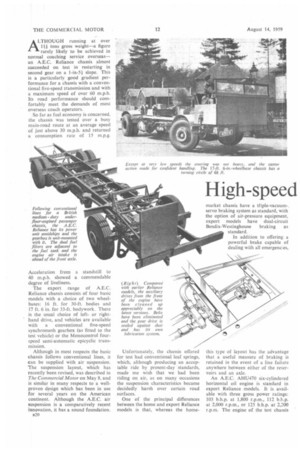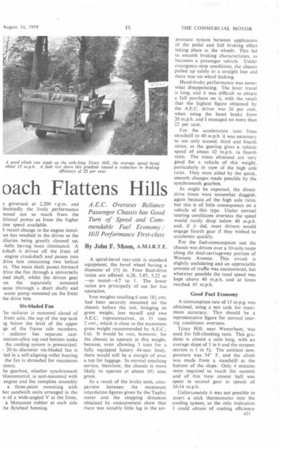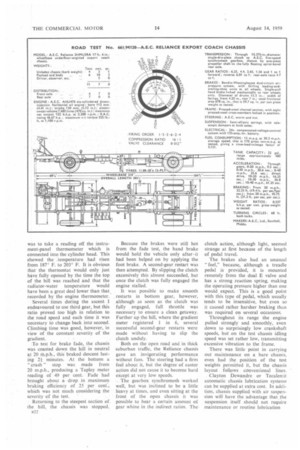High-speed oach Flattens Hills
Page 54

Page 55

Page 56

If you've noticed an error in this article please click here to report it so we can fix it.
A.E.C. Overseas Reliance Passenger Chassis has Good Turn of Speed and Commendable Fuel Economy : Hill Performance First-class
By John F. Moon, A.M.I.R.T.E. A.THOUGH running at over 111 tons gross weight—a figure rarely likely to be achieved in normal coaching service overseas— an A.E.C. Reliance chassis almost succeeded on test in restarting in second gear on a slope. This is a particularly good gradient performance for a chassis with a conventional five-speed transmission and with a maximum speed of over 60 m.p.h. Its road performance should comfortably meet the demands of most overseas coach operators.
So far as fuel economy is concerned. the chassis was tested over a busy main-road route at an average speed of just above 30 m.p.h, and returned a consumption rate of 15 m.p.g.
Acceleration from a standstill to 40 m.p.h. showed a commendable degree of liveliness.
The export range of A.E.C. Reliance chassis consists of four basic models with a choice of two wheelbases: 16 ft. for 30-ft. bodies and 17 ft. 6 in. for 33-ft. bodywork. There is the usual choice of leftor righthand drive, and vehicles are available with a conventional five-speed synchromesh gearbox (as fitted to the test vehicle) or the Monocontrol fourspeed semi-automatic epicyclic transmission.
Although in most respects the basic chassis follows conventional lines, it can be supplied with air suspension. The suspension layout, which has recently been revised, was described in The Commercial Motor on May 8, and is similar in many respects to a wellproven design which has been in use for several years on the American continent. Although the A.E.C. air suspension is a comparatively recent
innovation, it has a sound foundation. n20 Unfortunately, the chassis offered for test had conventional leaf springs, which, although producing an acceptable ride by present-day standards, made me wish that we had been riding on air, as on many occasions the suspension characteristics became decidedly harsh over certain road surfaces.
One of the principal differences between the home and export Reliance models is that, whereas the home
market chassis have a ttiple-vacuumservo braking system as standard, with the option of air-pressure equipment, export models have dual-circuit Bendix-Westinghouse braking as standard.
In addition to offering a powerful brake capable of dealing with all emergencies,
this type of layout has the advantage that a useful measure of braking is retained in the event of a line failure anywhere between either of the reservoirs and an axle.
An A.E.C. AHU470 six-cylinde red horizontal oil engine is standard in export Reliance models. It is available with three gross power ratings: 103 b.h.p. at 1,800 r.p.m., 112 b.h.p. at 2,000 r.p.m., or 125 b.h.p. at 2,200 r.p.m. The engine of the test chassis s governed at 2,200 r.p.m. and loubtedly the lively performance aimed not so much from the litional power as from the higher ;ine speed available.
's recent change in the engine instalon has resulted in the drives to the ;fliaries being greatly cleaned up, belts having been eliminated. A kshaft is driven off the front of engine crankshaft and passes into irive box containing two helical rs. The main shaft passes forward drive the fan through a universally ited shaft, whilst the driven gear yes the separately mounted tamo (through a short shaft) and water pump mounted on the front the drive box.
Six-bladed Fan
he radiator is mounted ahead of front axle, the top of the top tank ig below the level of the upper ge of the frame side members. ; radiator has separate castminium-alloy top and bottom tanks the cooling system is pressurized. 20-in.-diameter six-bladed fan is led in a self-aligning roller bearing the fan is shrouded for maximum :iertcy.
he gearbox, whether synchromesh Vionocontrol, is unit-mounted with engine and the complete assembly a three-point mounting with ber sandwich units arranged in the n of a wide-angled V at the front, a Metacone rubber at each side he flywheel housing.
A spiral-bevel rear-axle is standard equipment, the bevel wheel having a diameter of 15,1in. Four final-drive ratios are offered: 6.28, 5.87, 5.22 or —as tested-4.7 to I. The lower ratios are principally of use for bus operation.
Iron weights totalling 6 tons 181 cwt. had been securely mounted on the chassis before the test, bringing its gross weight, less myself and two A.E.C. representatives, to 11 tons 2 cwt., which is close to the maximum gross weight recommended by A.E.C.. Ltd. It would be rare, however, for the chassis to operate at this weight. because, even allowing 3 tons for a fully equipped luxury 44-seat body. there would still be a margin of over a ton for luggage. In normal coaching service, therefore, the chassis is more likely to operate at about 101 tons gross.
As a result of the brake tests, comparison between the maximum retardation figures given by the Tapley meter and the stopping distances obtained by measurement show that there was notably little lag in the air
pressure system between application of the pedal and full braking effect taking place at the wheels. This led to smooth braking characteristics, as becomes a passenger vehicle. Under emergency-stop conditions, the chassis pulled up safely in a straight line and there was no wheel locking.
Hand-brake performance was somewhat disappointing. The lever travel is long, and it was difficult to obtain a full purchase on it, with the result that the highest figure obtained by the A.E.C. driver was 26 per cent. when using the hand brake from 20 m.p.h. and I managed no more than 22 per cent.
For the acceleration tests from standstill to 40 m.p.h. it was necessary to use only second, third and fourth ratios, as the gearing gives a vehicle speed of about 42 m.p.h. in fourth ratio. The times obtained are very good for a vehicle of this weight, particularly in view of the high axle ratio. They were aided by the quick, smooth changes made possible by the synchromesh gearbox.
As might be expected, the directdrive times were somewhat sluggish, again because .of the high axle ratio, but this is of little consequence on a vehicle of this type. Under normal touring conditions overseas the speed would rarely drop below 40 m.p.h. and, if it did, most drivers would engage fourth gear if they wished to accelerate quickly.
For the fuel-consumption test the chassis was driven over a 10-mile route along the dual-carriageway portion of Western Avenue. This circuit is slightly undulating and an appreciable amount of traffic was encountered, but wherever possible the road speed was kept above 40 m.p.h, and at times reached 45 m.p.h.
Good Fuel Economy
A consumption rate of 15 m.p.g. was obtained, using a test tank for maximum accuracy. This should be a representative figure for normal touring conditions overseas.
Titsey Hill, near Westerham, was used for hill-climbing tests. This gradient is almost a mile long, with an average slope of 1 in 6 and the steepest section is 1 in 51-. The ambient temperature was 54° F. and the climb was made from a standstill at the bottom of the slope. Only 4 minutes were required to reach the summit and of this time almost half was spent in second gear at speeds of 10-14 m.p.h.
Unfortunately it was not possible to insert a stick thermometer into the cooling system, so the only indication I could obtain of cooling efficiency was to take a reading off the instrument-panel thermometer which is connected into the cylinder head. This showed the .temperature had risen from 187° F. to 203° F. It is obvious that the thermostat would only just have fully opened by the time the top of the hill was reached and that the radiator-water temperature would have been a great deal lower than that, recorded by the engine thermometer.
Several times during the ascent I endeavoured to use third gear, but this ratio proved too high in relation to the road speed and each time it was necessary to change back into second. Climbing time was good, however, in view of the constant severity of the gradient.
To test for brake fade, the chassis was coasted down the hill in neutral at 20 M.p.h., this braked descent lasting 21 minutes. At the bottom a " crash " stop was made from 20 m.p.h., producing a Tapley meter reading of 49 per cent. Fade had brought about a drop in maximum braking efficiency of 25 per cent:, which was not much considering the severity of the test.
Returning to the steepest section of the hill, the chassis was stopped. Because the brakes were still hot from the fade test, the hand brake would hold the vehicle only after-it had been helped on by applying the foot brake. A second-gear restart was then attempted. By slipping the clutch excessively this almost succeeded, but once the clutch was fully engaged the engine stalled.
It was possible to make smooth restarts in bottom gear, however, although as soon as the clutch was fully engaged, full throttle was necessary to ensure a clean getaway. Further up the hill, where the gradient meter registered 1 in 6, several successful second-gear restarts were made without having to slip the clutch unduly.
Both on the open road and in thick suburban traffic, the Reliance chassis gave an invigorating performance without fuss. The steering had a firm feel about it, but the degree of castor action did not cause it to become hard except at very low speeds.
The gearbox synchromesh worked well, but was inclined to be a little heavy at times, and even sitting at the front of the open chassis it was possible to hear a certain amount of gear whine in the indirect ratios. The,
clutch action, although light, seemed strange at first because of the length of pedal travel.
The brakes also had an unusual "feel," because, although a treadle pedal is provided, it is mounted remotely from the dual E valve and has a strong reaction spring, making the operating pressure higher than one would expect. This is a good point with this type of pedal, which usually tends to be insensitive, but even so it caused rather harsher braking than was required on several occasions.
Throughout its range the engine pulled strongly and smoothly, even down to surprisingly low crankshaft speeds, but on the test chassis idling speed was set rather low, transmitting excessive vibration to the frame.
There was little point in carrying out maintenance on a bare chassis, even had the position of the test weights permitted it, but the chassis layout follows conventional lines.
Clayton Dewandre or Tecalemit automatic chassis lubrication systems can be supplied at extra cost. In addition, chassis supplied with air suspension will have the advantage that the suspension itself should not require maintenance or routine lubrication




















































































































